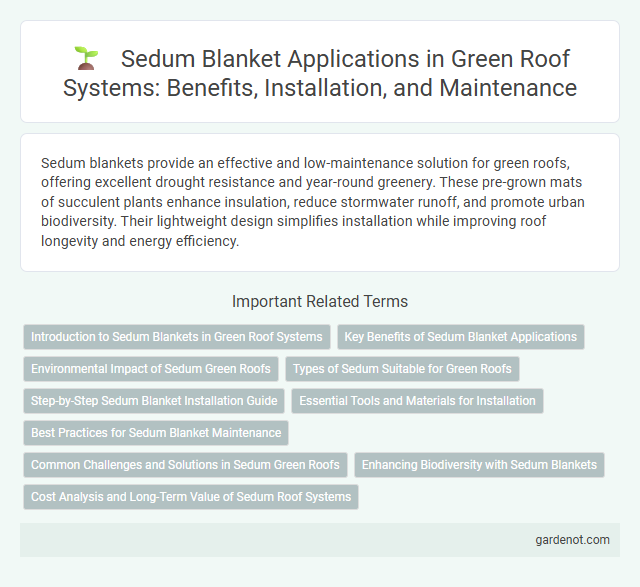Sedum blankets provide an effective and low-maintenance solution for green roofs, offering excellent drought resistance and year-round greenery. These pre-grown mats of succulent plants enhance insulation, reduce stormwater runoff, and promote urban biodiversity. Their lightweight design simplifies installation while improving roof longevity and energy efficiency.
Introduction to Sedum Blankets in Green Roof Systems
Sedum blankets are pre-grown mats of drought-tolerant succulent plants designed for rapid installation on green roofs, offering immediate vegetation cover and erosion control. These blankets typically consist of various Sedum species known for their low maintenance, resilience to extreme weather, and ability to improve roof insulation and stormwater management. Sedum blankets enhance the overall performance of extensive green roof systems by promoting biodiversity, reducing urban heat island effects, and extending roof lifespan.
Key Benefits of Sedum Blanket Applications
Sedum blankets offer exceptional water retention, reducing stormwater runoff and minimizing soil erosion on green roofs. These blankets provide a lightweight, low-maintenance vegetation cover that enhances insulation, leading to energy savings and extended roofing material lifespan. Their drought-tolerant nature and rapid establishment promote robust greenery, contributing to urban biodiversity and improved air quality.
Environmental Impact of Sedum Green Roofs
Sedum blankets on green roofs significantly reduce urban heat island effects by providing natural insulation and cooling through evapotranspiration. These low-maintenance, drought-resistant succulent plants improve air quality by filtering pollutants and capturing airborne particulates. Sedum green roofs also enhance stormwater management by absorbing rainfall, decreasing runoff, and mitigating flood risks in urban areas.
Types of Sedum Suitable for Green Roofs
Sedum blankets for green roofs commonly include drought-tolerant species such as Sedum acre, Sedum album, and Sedum spurium, which thrive in shallow substrates and withstand extreme weather conditions. Sedum reflexum and Sedum sexangulare are also popular for their rapid ground coverage and minimal maintenance requirements. Selecting the right Sedum varieties enhances the green roof's resilience, promotes biodiversity, and improves stormwater retention.
Step-by-Step Sedum Blanket Installation Guide
Place the prepared roof surface with a root barrier and drainage layer before unrolling the Sedum blanket carefully to avoid damage. Overlap edges by 2 to 4 inches to ensure full coverage and secure the blanket with biodegradable staples if necessary. Water the blanket thoroughly after installation and maintain regular irrigation during the first few weeks to promote healthy root establishment.
Essential Tools and Materials for Installation
A Sedum blanket installation requires essential tools such as a utility knife, garden gloves, a rake, and a watering hose to ensure proper handling and placement. Key materials include the Sedum blanket itself, a lightweight growing medium, an effective waterproof membrane, and landscape fabric to prevent weed growth. Proper preparation of the roof surface and secure anchoring systems are critical to promote healthy plant establishment and long-term green roof performance.
Best Practices for Sedum Blanket Maintenance
Sedum blanket maintenance involves regular inspection to ensure proper hydration, weed control, and prompt removal of dead plant material to promote healthy growth. Monitoring moisture levels is crucial, as Sedum blankets require minimal but consistent watering, especially during establishment and drought periods. Implementing these best practices enhances the longevity and aesthetic appeal of green roofs utilizing Sedum blankets.
Common Challenges and Solutions in Sedum Green Roofs
Sedum blankets on green roofs often face challenges such as drought stress, poor substrate drainage, and limited nutrient availability, leading to patchy growth and plant mortality. Implementing well-draining, lightweight substrates combined with regular irrigation systems and slow-release fertilizers helps mitigate these issues and promotes resilient Sedum coverage. Selecting drought-tolerant Sedum species and ensuring proper installation techniques further enhance long-term performance and green roof sustainability.
Enhancing Biodiversity with Sedum Blankets
Sedum blankets enhance biodiversity by providing diverse microhabitats that support various pollinators and insects in urban environments. The extensive root systems of Sedum species improve soil structure and water retention, promoting healthier microbial communities. These low-maintenance green roof components contribute to urban resilience by increasing plant diversity and supporting local ecosystems.
Cost Analysis and Long-Term Value of Sedum Roof Systems
Sedum blanket installation offers a cost-effective green roof solution with moderate upfront expenses averaging $12 to $20 per square foot, balancing affordability and efficiency. Long-term value stems from reduced maintenance costs, extended roof lifespan up to 40 years, and energy savings with 10-15% lower cooling expenses annually. These factors combine to provide significant return on investment, making Sedum roof systems economically advantageous over conventional roofing options.
Sedum blanket Infographic

 gardenot.com
gardenot.com